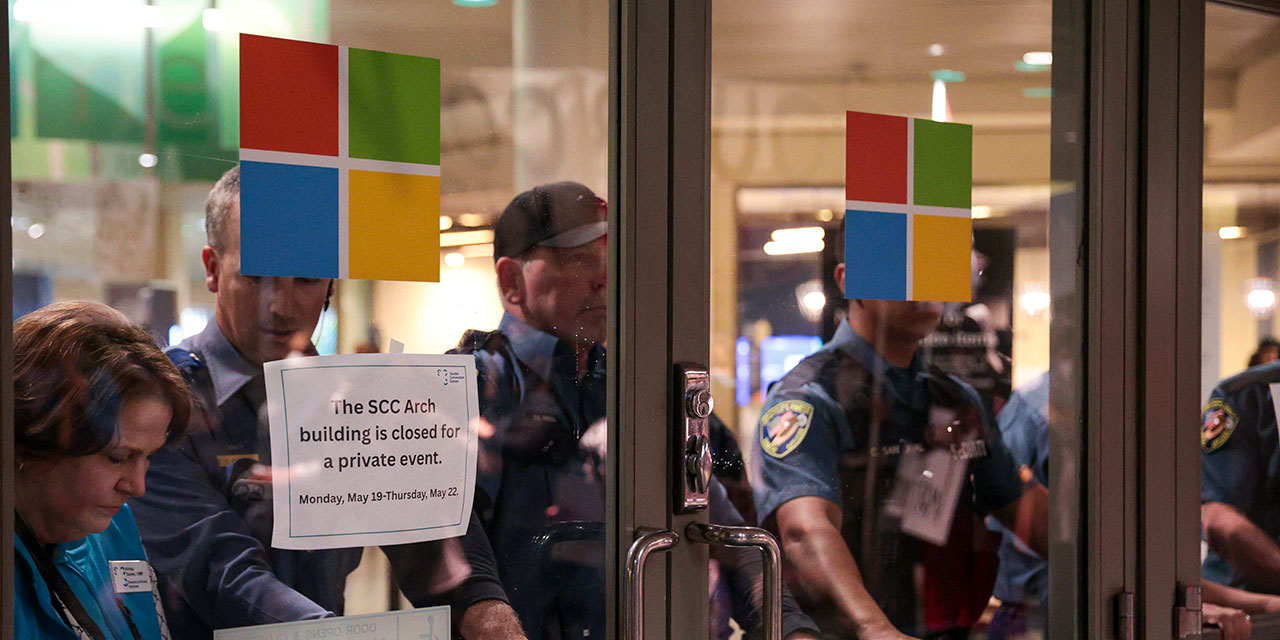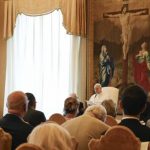
Pro-Palestinian activists have found a new target: Microsoft. Radicals have disrupted the company’s keynote speech; organized encampments and other demonstrations at its headquarters; sent a kayak “flotilla” to the homes of Microsoft executives; and staged an “occupation” of Microsoft president Brad Smith’s office, where they allegedly tried to plant listening devices.
The leader of the campaign is No Azure for Apartheid, a group of current and former Microsoft employees. The group, whose name references the company’s cloud-computing platform, has called on Microsoft to terminate its Azure contracts with the Israeli government, publicly endorse a ceasefire, pay reparations to Palestinians, and “ensure the safety of Palestinian, Arab, Muslim and allied employees.”
No Azure is connected with a broader network of radical pro-Palestinian groups in Seattle. Some of these organizations suggest that their supporters emulate Hamas; others praise the “tactics of resistance” deployed in Kashmir. At least one of these groups played a central role in the occupation of the University of Washington’s engineering building, which caused over a million dollars in damage and marked the start of a coordinated disruption campaign across Seattle. This movement, left unchecked, could inspire similar radical actions nationwide.
Pro-Palestinian activity has roiled Microsoft for over a year. No Azure’s campaign began with a public petition, released on “Nakba Day” in 2024, accusing the company of “a pattern of militarization, lack of oversight, and disregard for” its “own policies and commitments.” The campaign accelerated in February, when members of the group attended a Microsoft townhall wearing matching shirts asking “Does Our Code Kill Kids, Satya?” in reference to CEO Satya Nadella.
Disruptions mounted in the months ahead. In March, a pro-Palestinian protester interrupted Microsoft’s 50th anniversary event. At an event in April, two Microsoft employees—Ibtihal Aboussad and Vaniya Agrawal—threw a keffiyeh on stage and disrupted a speaker, respectively. Aboussad and Agrawal both sent mass emails to Microsoft workers and were eventually fired.
By May, No Azure was openly calling for escalation just in time for Microsoft Build, the company’s annual developer conference. On May 19, protesters interrupted CEO Satya Nadella’s keynote. In the days that followed, the group deployed a range of tactics, including dropping a banner outside the convention center; using sound makers to disrupt the event; and marking the center’s entrance with red glitter to represent blood. They eventually became such a public nuisance that at least one demonstrator was arrested.
Microsoft Build panels were also attacked. Jay Parikh, executive VP of Microsoft CoreAI, had his keynote speech disrupted. Fired Microsoft employees Hossam Nasr and Vaniya Agrawal infiltrated and interrupted an event with Sarah Bird, chief product officer of responsible AI.
No Azure later wreaked havoc at the Microsoft-sponsored Ethics and Tech Conference 2025 at Seattle University. Mirroring tactics deployed at Microsoft Build, demonstrators shouted down Seattle University president Eduardo Peñalver, used sound-disruption techniques, and even chased Microsoft’s general manager Mike Jackson off the stage before taking it themselves.
If Shakespeare was right that “past is prologue,” Microsoft should have expected No Azure’s August onslaught. On August 19, No Azure and its allies set up a “liberated zone,” which kicked off everything from the flotilla to the eventual occupation of president Brad Smith’s office.
No Azure’s actions are part of a broader campaign of pro-Palestinian radicalism in Seattle. That campaign accelerated in May, when an occupation of the University of Washington’s brand-new Interdisciplinary Engineering Building culminated in the arrests of 33 demonstrators. The protesters blocked entrances, set dumpsters on fire, created explosions using e-scooters, and were ultimately removed from the building by force.
While many of the UW protesters were affiliated with Students United for Palestinian Equality and Return (SUPER UW), some were also involved with other groups. Anna Hattle and Jade Chen Wu, for example, were arrested at both UW and a later No Azure event.
The University of Washington suspended SUPER UW in fall 2024, but the group continues to operate on campus and collaborate with No Azure. SUPER UW recently co-hosted an event called “Genocidal Tech is Cooked” with No Azure and joined the Microsoft demonstrators in endorsing an upcoming march for Gaza.
A week after the occupation of the engineering building, a new organization called Nidal was formed in Seattle. (Nidal is the Arabic word for “struggle.”) The group’s militancy is reflected in its logo, which resembles an AK-47 turned upside down.
Nidal’s mission is to create “a culture of resistance that resembles the one back home.” Its manifesto cites Hamas leader Yahya Sinwar and Popular Front for the Liberation of Palestine spokesman Ghassan Kanafani as models. The group’s aim is to create a “popular cradle” that will support resistance from within the “imperial core.”
It has focused its activism on the fate of the “UW33,” the 33 activists and University of Washington students arrested during the occupation of the engineering building. Nidal, which has organized an event with SUPER UW, has called for all suspensions and charges to be dropped. The group also advocated for the release of Elias Rodriguez, who allegedly murdered two Israeli embassy staffers in D.C., and expressed its “firm solidarity” with Palestine Action UK, which has been labeled a terrorist organization by the United Kingdom.
Nidal, No Azure, and the UW33 are part of a larger radical contingent in Seattle. The city is home to groups like Sông2Sea, South Asians Resisting Imperialism, bil-Yad, and the Kashmir Resistance Collective, which variously host radical teach-ins, organize fundraisers, and align themselves with the city’s more militant movements.
Will activists who break the law be held responsible? The King County Prosecuting Attorney’s Office still has not pressed charges for the vandalism at UW.
“Will people be held accountable for the million-plus dollars’ worth of damage? The answer is yes, if there’s evidence to do so,” office spokesperson Casey McNerthney told local news. “And many people would look and say, ‘You’re in the building; there’s a lot of damage.’ That’s enough evidence for me, but it’s not enough evidence under the law.”
It’s little wonder that Microsoft has sought the local FBI office’s involvement. Still, federal law enforcement officials should look beyond No Azure and its network of tech workers. That group is merely one head of a much larger hydra—one that could inspire radicals in other cities if it is not disrupted.
Photo by JASON REDMOND/AFP via Getty Images
City Journal is a publication of the Manhattan Institute for Policy Research (MI), a leading free-market think tank. Are you interested in supporting the magazine? As a 501(c)(3) nonprofit, donations in support of MI and City Journal are fully tax-deductible as provided by law (EIN #13-2912529).

















